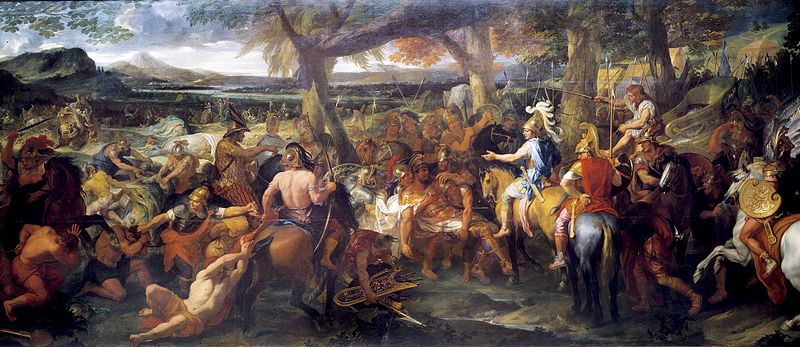
A photorealistic representation of Alexander the Great (r. 336-323 BCE) as he may have appeared in life. / Arienne King via worldhistory.org
A photorealistic representation of Alexander III of Macedonia (more familiarly known as Alexander the Great) depicting how he may have appeared in life, was published on the World History Encyclopedia website a year ago. The internet being what it is, I only got to see it last week.
The author of the picture, Arienne King, used Artbreeder, an AI neural network, to generate the reconstruction based on archaeological evidence. King used busts, coin portraits and statuary, as well as descriptions of Alexander in historical accounts.
And this got me thinking about the story of Porus; an ancient Indian king circa 4th century BC, because the tale was told to me many times during my childhood.
But before that, a 10 point background on Alex himself.
1. Born 21 July 356 BC, he became king in 336 BC, aged 20.
2. At age 22, he conquered Ephesus (in modern Turkey). In the same year, he conquered Sardis, capital of the ancient kingdom of Lydia (also in modern Turkey), and an important city in the Persian empire.
3. The following year age 23, he conquered Aleppo (in modern day Syria), and defeated Darius III of Persia.
4. At age 24, he conquered Phoenicia (which roughly comprises modern day Lebanon, and coastal areas of Syria and Israel including Gaza).
5. At age 25, Sidon (also modern Lebanon) fell, following which he sacked the ancient Egypt city of Baalbek, renaming it Heliopolis The rest of the Levant followed (present-day Syria, Lebanon, Jordan, Israel, Palestine and most of Turkey southwest of the middle Euphrates) during which he razed the city of Tyre in Lebanon over six months from January to July.
6. At age 26, he conquered Egypt and founded the city of Alexandria which bears his name to this day. Later that year, he moved took the city of Susa (which is Shush in modern day Iran).
7. He once again took on Darius III of Persia, defeating him conclusively in the Battle of Gaugamela. At this point, he declared himself King of Asia.
8. The following year age 27, he looted and burned Persepolis (also in modern day Iran).
9. In 329 BC aged 28, Alexander conqueredBactria (Iran) and Sogdiana (which is spread across present-day Uzbekistan, Tajikistan, Kazakhstan, and Kyrgyzstan). Later that year, he conclusively defeated the Scythians at Iaxartes , sacked the city of Cyropolis, and established the town of Alexandria Eschate (named after him and meaning "Furthest Alexandria") in modern day Tajikistan.
10. In 327 BC, before his 30th birthday, Alexander married Roxana, daughter of a Bactrian leader named Oxyartes. (Her name is depicted in various languages as Roxanne, Roxanna, Rukhsana, Roxandra and Roxane — all meaning "shining", "radiant", "brilliant".)
Some histories of the time say his marriage to Roxanne was love at first sight. I'm skeptical because after the marriage, Alex set off towards India, which is where we come back to Porus...
Paurava, as Indians refer to him, had territory spanning the region between the Jhelum River and Chenab River. This is more or less the area between Islamabad and Faisalabad in what is modern-day Pakistan. Some accounts describe his territory as covering more than 300 cities. There was hostility between his kingdom and Taxila which was ruled by his extended family; Porus is recorded as having assassinated a ruler of Taxila, Ambhiraj, who was Porus's mother's brother.
When Alexander crossed the Indus river, he was welcomed with open arms at Taxila by Porus's cousin Ambhi, son of the assassinated Ambhiraj. Alexander accepted Ambhi's surrender and rewarded him by appointing him as his satrap. He then sent ambassadors to Porus, asking him to surrender too.
Porus refused.
The conflict which followed, Battle of the Hydaspes , is the stuff of legends, In pouring rain, Porus's mighty elephants were encircled by the nimbler cavalry of Alexander. Porus's army's longbows which required one end be planted in the ground, were ineffective in muddy conditions. Porus's defeat was certain.
But let me quote the Wikipedia account of the climax:
Throughout the battle, Alexander is said to have observed with growing admiration the valour of Porus, and understood that Porus intended to die in combat rather than be captured. Hoping to save the life of such a competent leader and warrior, Alexander commanded Ambhi to summon Porus for surrender. However, Porus became enraged on the very sight of his nemesis and tossed a spear at him in fury without bothering to listen to his proposal. Porus's aggressive response forced Ambhi to take flight on his steed.
In a similar manner, many other messengers dispatched by the determined Alexander were spurned until at last Meroes, a personal friend of Porus, convinced him to listen to Alexander's message.
Overpowered by thirst, the weary Porus finally dismounted his war elephant and demanded water. After being refreshed, he allowed himself to be taken to Alexander. On hearing that the Indian King was approaching, Alexander himself rode out to meet him
Alexander asked Porus how he wished to be treated. Porus replied "Treat me as you would a fellow king".
Alexander did exactly that. He released Porus from captivity, restored Porus's lands to him, and allocated further territory to Porus which Alexander had captured. He brokered peace between Porus and his cousin Ambhi.
It was the turning point in Alexander's march of conquest. He wanted to go further but his armies were wanting to return home.So he headed back to the west.
So, let's leave our story there with Alexander, aged 30, as the greatest ruler in the world at the time. Today, he would need to be five years older to run for election as president of the United States.

A painting by Charles Le Brun depicting Alexander and Porus during the Battle of the Hydaspes.
